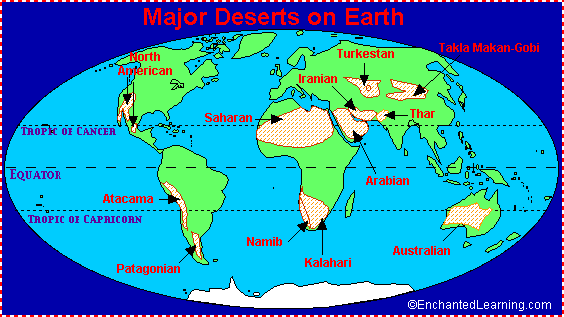
AIMS:
1. Where are the world's deserts located?
2. What are the types of desert terrain?
MOTIVATION: Have students look at a biome map of the world with the desert biome highlighted. A good map to use is taken from http://enchantedlearning.com/biomes.
|
|
PROCEDURE:
1. Have students review from the previous lesson what are some causes of desertification? (They can review this information at http://mbgnet.mobot.org/sets/desert/index.htm).
2. Have students label a blank world map with the locations of the world's deserts. The following map was taken from http://EnchantedLearning.com and can be printed from that site.
Copyright ©2001-2002 EnchantedLearning.com
|
3. Explain to the students that not all deserts share the same physical terrain. Show the class the following examples of desert terrain taken from various websites.
|
|
|
|
|
|
4. Have the students fill in a database on the five different types of deserts. They will link to the following website http://library.thinkquest.org/28855/landscape.html
|
TYPE OF TERRAIN |
DESCRIPTION |
|
SAND DESERTS |
|
|
STONY DESERTS |
|
|
ROCKY DESERTS |
|
|
PLATEAU DESERTS |
|
|
MOUNTAIN DESERTS |
|
ACTIVITY:
The following activity is written in Scientific Method and taken from Earth Science for Every Kid, by Janice Van Cleave, John Wiley and Sons, Inc. N.Y. 1991
Problem: How can we demonstrate the formation of sand dunes?
Hypothesis: We think if sand dunes are created by the force of wind, then we can create a sand dune by using our breath to push flour.
Materials: Drinking straw, flour, and shallow baking pan.
Procedure:
1. Cover the bottom of the baking pan with a thin, flat layer of flour.
2. Use the straw to direct your exhaled breath toward the edge of the flour.
Observations: The flour moves away from the end of the straw in a semicircular pattern. The flour piles up close to the end of the straw.
Conclusion: The moving air leaving the straw has kinetic energy (energy of motion). The flour particles are small enough to be lifted by the moving air and carried forward. Some of the smaller particles move farther away, but most lose energy and fall, forming a mound near the end of the straw. As this mound builds, it blocks the movement of even the smaller flour particles that would have traveled farther. This demonstrates the formation of sand dunes.
FOLLOW-UP: This lesson will lead to the next lesson: What are some desert plants?